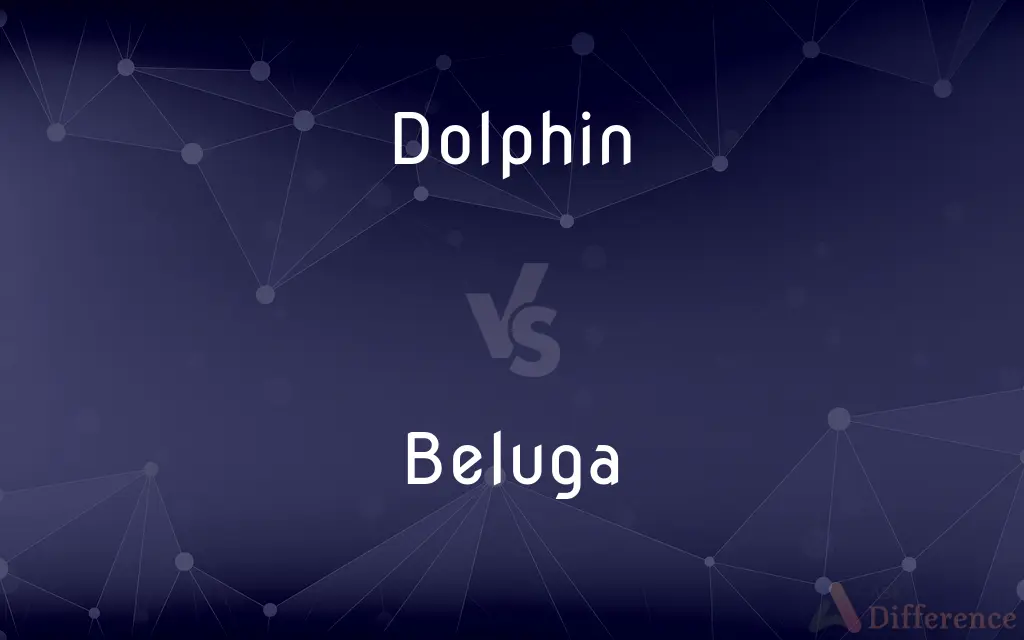Dolphin vs. Beluga — What's the Difference?
By Tayyaba Rehman & Maham Liaqat — Updated on April 15, 2024
Dolphins are known for their streamlined bodies and high intelligence, while belugas, distinct with their white color and bulbous heads, are Arctic-adapted cetaceans.

Difference Between Dolphin and Beluga
Table of Contents
ADVERTISEMENT
Key Differences
Dolphins typically inhabit warmer waters and have a diverse range of species, whereas belugas are primarily found in the cold Arctic and sub-Arctic waters.
While dolphins are celebrated for their agility and speed, achieving up to 60 km/h, belugas are slower swimmers, adapted to navigate icy waters.
Dolphins use a sophisticated echolocation system to hunt and communicate, whereas belugas also possess echolocation but are specifically known for their diverse vocal abilities, earning them the nickname "canaries of the sea."
In terms of social structure, dolphins are often observed in large, dynamic groups called pods, on the other hand, belugas also form groups but their social interactions are highly influenced by the Arctic's seasonal changes.
Regarding conservation, many dolphin species face threats from fishing and habitat loss, while belugas are additionally threatened by climate change impacts on Arctic ice.
ADVERTISEMENT
Comparison Chart
Habitat
Warmer oceanic waters
Cold Arctic and sub-Arctic waters
Color
Mostly grey
White
Social Structure
Large, dynamic pods
Smaller, seasonally variable groups
Echolocation Ability
Highly developed, used for hunting and communication
Also developed, with unique vocalizations
Speed
Can reach speeds of up to 60 km/h
Slower, adapted for icy waters
Compare with Definitions
Dolphin
Often interacts socially with other species, including humans.
Dolphins have been known to guide stranded swimmers to safety.
Beluga
Has adaptations like a thick layer of blubber for insulation against freezing temperatures.
The blubber of a beluga can be several inches thick.
Dolphin
Belongs to the family Delphinidae, characterized by their elongated bodies and dorsal fins.
The bottlenose dolphin is one of the most recognized species.
Beluga
Lives in cold water environments, often near sea ice.
Belugas migrate as the ice pack expands and contracts.
Dolphin
A highly intelligent marine mammal known for its playful nature.
Dolphins are often seen jumping above the water's surface.
Beluga
Known for its vocal behavior, communicating through various clicks, whistles, and clangs.
Beluga whales are sometimes called the 'canaries of the sea'.
Dolphin
Utilizes echolocation to navigate and hunt in murky waters.
Dolphins emit clicks that bounce off fish, revealing their location.
Beluga
A small whale of the Arctic, easily recognizable by its white color and rounded forehead.
Belugas can change the shape of their bulbous head.
Dolphin
Threatened by environmental and human factors, requiring conservation efforts.
Fishing nets pose serious risks to dolphin populations.
Beluga
Faces threats from climate change and habitat degradation.
Melting sea ice affects the beluga's natural habitat.
Dolphin
Dolphin is the common name of aquatic mammals within the infraorder Cetacea. The term dolphin usually refers to the extant families Delphinidae (the oceanic dolphins), Platanistidae (the Indian river dolphins), named Iniidae (the New World river dolphins), and Pontoporiidae (the brackish dolphins), and the extinct Lipotidae (baiji or Chinese river dolphin).
Beluga
A small toothed whale (Delphinapterus leucas) chiefly of the Arctic Ocean, having a bulbous forehead and a white body when full-grown. Also called white whale.
Dolphin
Any of various marine toothed whales of the family Delphinidae, having a beaklike snout, a curved dorsal fin, and a slender streamlined body.
Beluga
A large white anadromous sturgeon (Huso huso) of the Black and Caspian Seas, valued for its roe. Also called beluga sturgeon, whitefish.
Dolphin
Any of several toothed whales inhabiting rivers and estuaries in South America and South Asia, having a long narrow beak, broad flippers, a flexible neck, and usually a reduced dorsal fin. A species native to the Yangtze River is thought to be extinct. Also called river dolphin.
Beluga
Caviar made from the roe of this fish, having large grayish grains.
Dolphin
See dolphinfish.
Beluga
A cetacean, Delphinapterus leucas, found in the Arctic Ocean.
Dolphin
See pompano dolphinfish.
Beluga
A fish found in the Caspian Sea and the Black Sea (Huso huso), that is a source of caviar.
Dolphin
A buoy, pile, or group of piles used for mooring boats.
Beluga
A cetacean allied to the dolphins.
Dolphin
A group of piles used as a fender, as at a dock or around a bridge pier.
Beluga
The sturgeon (Huso huso) native to the Black Sea and Caspian Sea; - also called hausen. It is valued for its roe, sold as caviar, and is also used for production of isinglass. See also sturgeon.
Dolphin
A carnivorous aquatic mammal in one of several families of order Cetacea, famed for its intelligence and occasional willingness to approach humans.
Beluga
The caviar obtained from the beluga{2}; - also called beluga caviar. The caviar of the beluga is considered the finest sort, larger and of a taste superior to that obtained from other sturgeon. See also sturgeon and caviar.
Dolphin
Tursiops truncatus, (Atlantic bottlenose dolphin) the most well-known species.
Beluga
Valuable source of caviar and isinglass; found in Black and Caspian seas
Dolphin
A fish, the mahi-mahi or dorado, Coryphaena hippurus, with a dorsal fin that runs the length of the body, also known for iridescent coloration.
Dolphin
(heraldry) A depiction of a fish, with a broad indented fin, usually embowed.
Dolphin
The dauphin, eldest son of the kings of France.
Dolphin
(history) A mass of iron or lead hung from the yardarm, in readiness to be dropped through the deck and the hull of an enemy's vessel to sink it.
Dolphin
(nautical) A kind of wreath or strap of plaited cordage.
Dolphin
(nautical) A spar or buoy held by an anchor and furnished with a ring to which ships may fasten their cables.
Dolphin
(nautical) A mooring post on a wharf or beach.
Dolphin
(nautical) A permanent fender designed to protect a heavy boat or coastal structure from the impact of large floating objects such as ice or floating logs.
Dolphin
One of the handles above the trunnions by which a gun was lifted.
Dolphin
(nautical) A man-made semi submerged maritime structure, usually installed to provide a fixed structure for temporary mooring, to prevent ships from drifting to shallow water or to serve as base for navigational aids.
Dolphin
A cetacean of the genus Delphinus and allied genera (esp. Delphinus delphis); the true dolphin.
Dolphin
The Coryphæna hippuris, a fish of about five feet in length, celebrated for its surprising changes of color when dying. It is the fish commonly known as the dolphin. The term is also applied to the related Coryphaena equisetis. Called also dolphinfish and (especially in Hawaii) mahimahi. See also dolphinfish and Coryphænoid.
Dolphin
A mass of iron or lead hung from the yardarm, in readiness to be dropped on the deck of an enemy's vessel.
Dolphin
A kind of wreath or strap of plaited cordage.
Dolphin
In old ordnance, one of the handles above the trunnions by which a cannon was lifted.
Dolphin
Large slender food and game fish widely distributed in warm seas (especially around Hawaii)
Dolphin
Any of various small toothed whales with a beaklike snout; larger than porpoises
Common Curiosities
Can dolphins and belugas live in freshwater?
Some dolphin species can inhabit freshwater environments, but belugas are strictly marine though they occasionally venture into river estuaries.
What are the main habitats of dolphins and belugas?
Dolphins typically inhabit warmer, temperate, and tropical waters, while belugas are found in the cold Arctic and sub-Arctic seas.
How do dolphins and belugas communicate?
Dolphins use complex echolocation and vocalizations to communicate, while belugas are known for their wide range of sounds, earning them the nickname "canaries of the sea."
What are typical threats to dolphins and belugas?
Dolphins face threats primarily from fishing and habitat destruction, whereas belugas also face significant impacts from climate change.
What is the conservation status of dolphins and belugas?
The conservation status varies widely among dolphin species; many are least concern, but some are endangered. Belugas are generally classified as near threatened due to habitat loss and pollution.
What are the typical life spans of dolphins and belugas?
Dolphins can live up to 50 years, depending on the species. Belugas have a similar lifespan, typically living up to 40-50 years in the wild.
Where can dolphins and belugas be found in the wild?
Dolphins are found in diverse marine environments worldwide, from shallow coastal waters to deep oceans, whereas belugas are primarily found in Arctic and sub-Arctic waters.
What do dolphins and belugas eat?
Dolphins have a varied diet, mainly consisting of fish and squid. Belugas, on the other hand, eat fish, crustaceans, and worms, depending on their habitat's availability.
What are the main differences between dolphins and belugas?
Dolphins are typically slimmer with elongated bodies and beak-like snouts, while belugas are bulkier with distinctive round, white heads and no beak.
How social are dolphins compared to belugas?
Dolphins are extremely social, often living in large pods and displaying complex social behaviors. Belugas are also social creatures, typically forming smaller groups than dolphins.
How do dolphins and belugas cope with cold water environments?
Most dolphins have a layer of blubber, but tend to inhabit warmer waters. Belugas have a thicker layer of blubber and are adapted to live in icy Arctic waters.
Share Your Discovery

Previous Comparison
Wonga vs. Tonga
Next Comparison
Giraffe vs. LionAuthor Spotlight
Written by
Tayyaba RehmanTayyaba Rehman is a distinguished writer, currently serving as a primary contributor to askdifference.com. As a researcher in semantics and etymology, Tayyaba's passion for the complexity of languages and their distinctions has found a perfect home on the platform. Tayyaba delves into the intricacies of language, distinguishing between commonly confused words and phrases, thereby providing clarity for readers worldwide.
Co-written by
Maham Liaqat















































